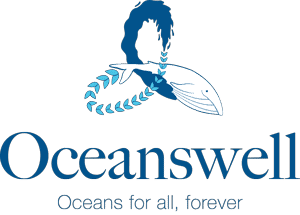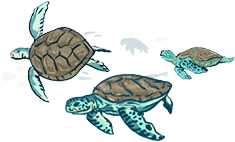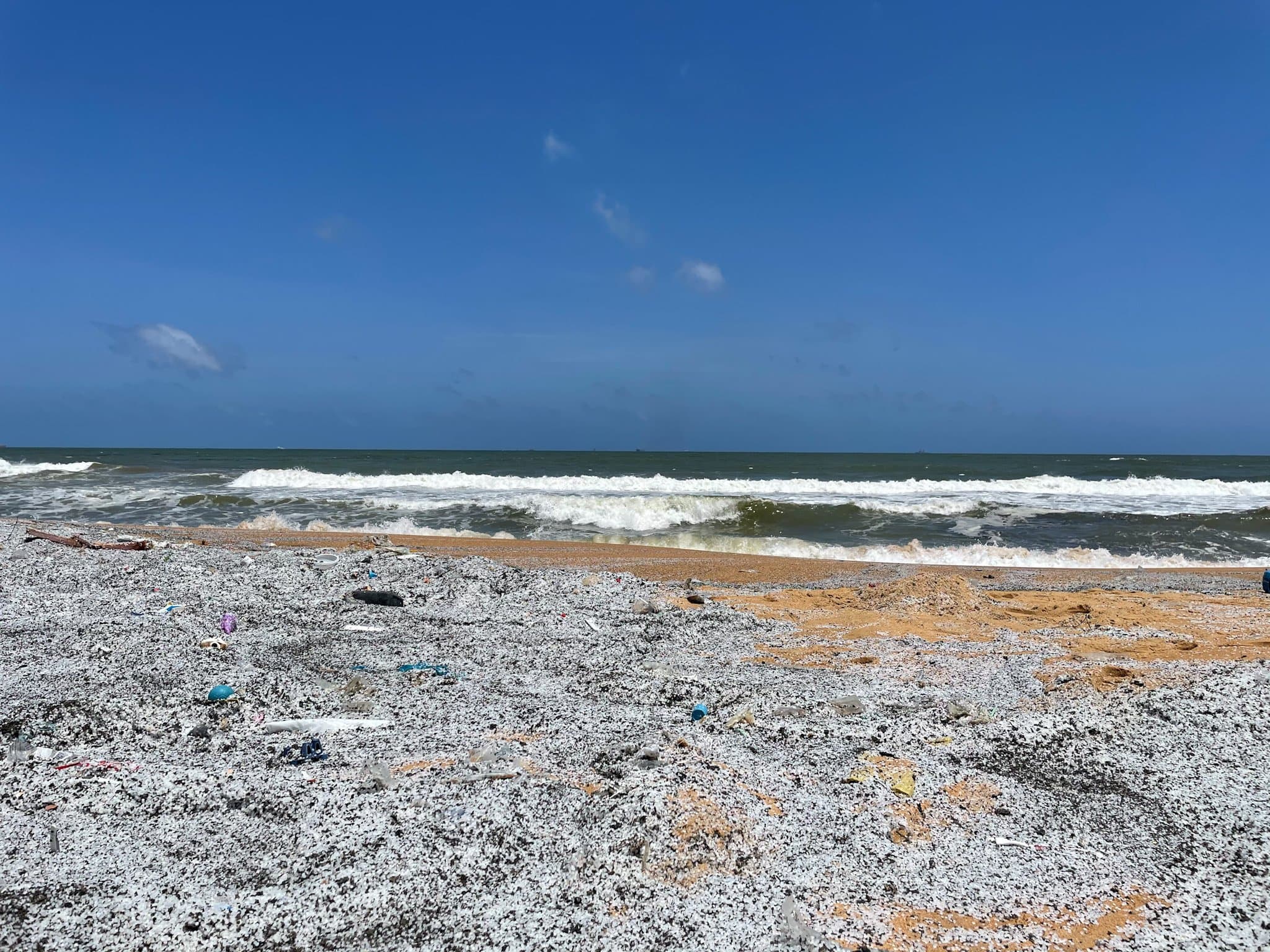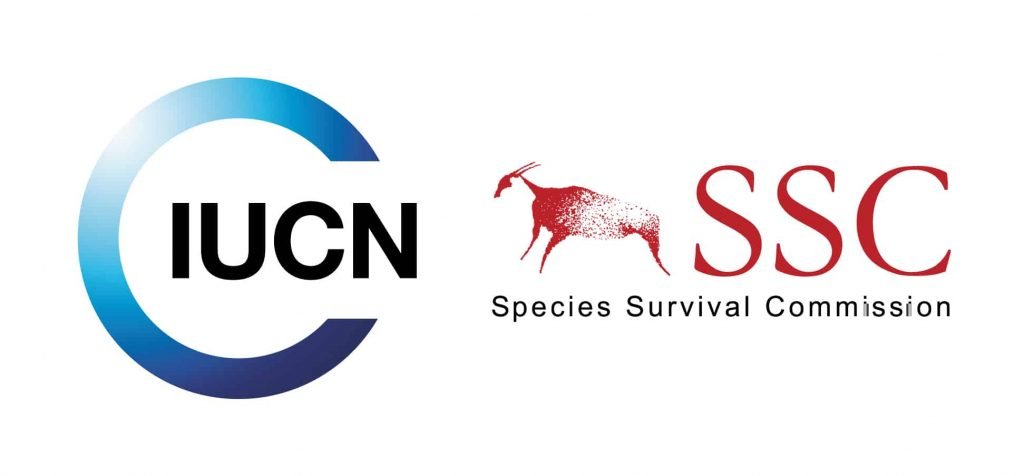Clarification related to comments made on 5th July on Derana TV
Prepared in collaboration with Dr. Chris Reddy at the Woods hole Oceanographic Institution
Frequently Asked Questions
On May 20, 2021, the cargo ship M/V X-Press Pearl caught fire while anchored off the coast of Sri Lanka, near the capital city of Colombo. According to news reports, the container ship was carrying nitric acid, urea fertiliser, sulphuric acid, ethanol, sodium hydroxide, lubricants and other chemicals, along with 78 metric tons (170,000 pounds) of a material known as plastic nurdles.
Many of the shipping containers containing these materials have burned or fallen into the ocean, releasing their contents into the water. At the moment, no one knows how much of which materials were released. But the presence of plastic nurdles on beaches near the ship are visual proof that at least some of that cargo spilled. An unknown portion of the cargo is continuing to wash on shore.

This “nurdling” of the coastline is just part of an ongoing global trend of plastic entering the ocean. Although there are considerable uncertainties about the amount and source of this plastic pollution, the amount of plastic entering the ocean via rivers is estimated to be between 1.15 and 2.41 million metric tons per year.
Although the current spill represents just a tiny fraction of the global annual input, the M/V X-Press Pearl spill is unprecedented, its impacts concentrated over a relatively short period of time, in a small volume of ocean, and along short, but growing extent of coastline. One study estimated that Sri Lankans release 3 kilograms of plastic waste per capita each year, making this spill equivalent to the annual output of as many as 26,000 Sri Lankans in almost a single day.
Nurdles are small plastic pellets that are melted down and used in the manufacture of a wide range of end-products. They can be made of any number of plastic polymers and resins; reports about the M/V X-Press Pearl spill indicate that the nurdles released were made of polyethylene (PE). PE is less dense than seawater, which means the nurdles released should float initially. As time passes, exposure to the marine environment may alter their density enough that they sink. This makes nurdles easy to skim off the surface and causes them to aggregate large, visible masses on beaches and elsewhere along the coast.
The presence of nurdles in coastal areas has been recognized as a potential problem since the 1970s, when scientists from the Woods Hole Oceanographic Institution (WHOI) first identified them and studied their composition and potential environmental impacts. Today, high-density polyethylene (HDPE) and low-density polyethylene (LDPE) are two of the most abundant plastics in the ocean.
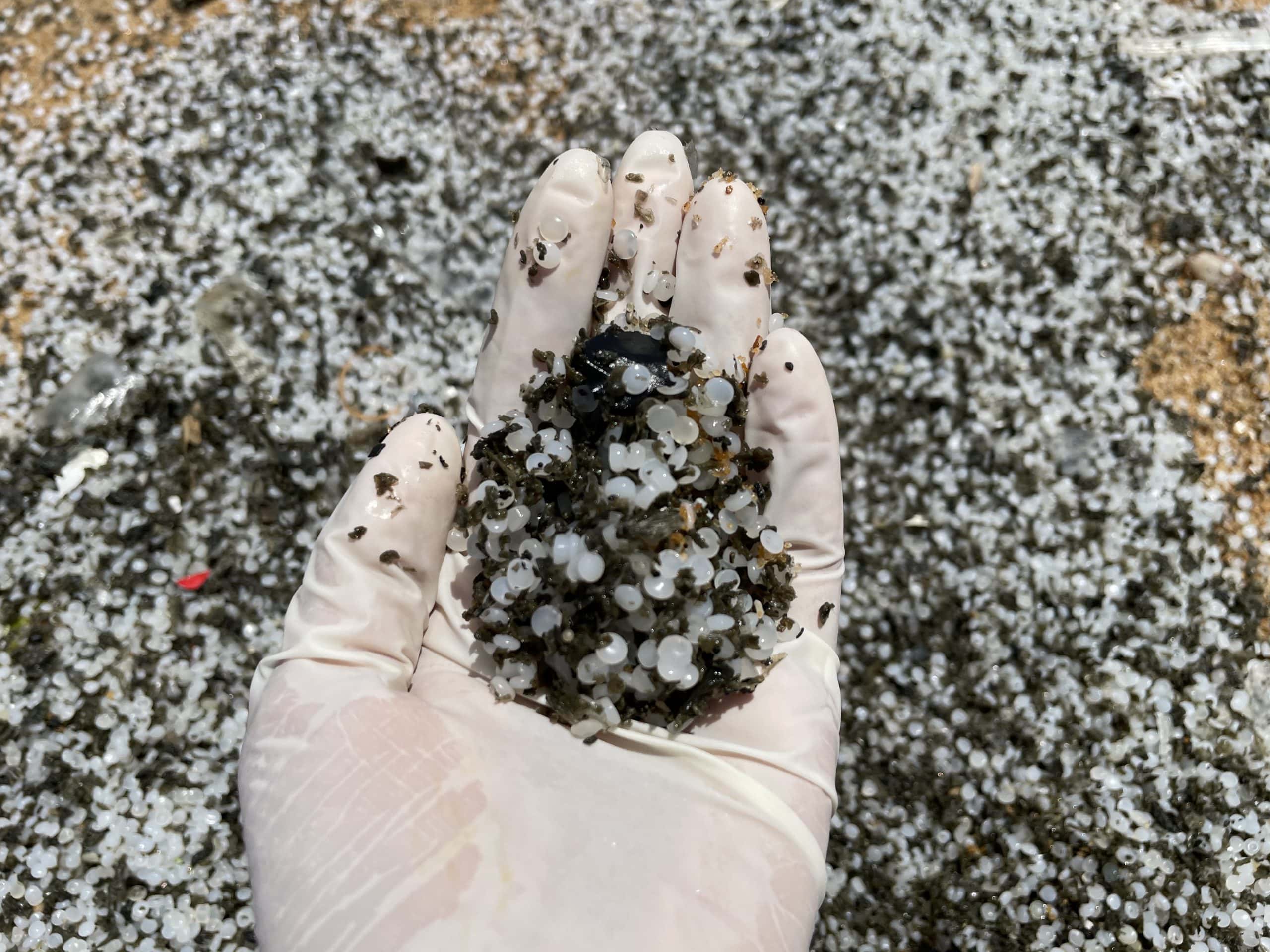
More information about nurdles and plastics in the ocean:
- Carpenter, EJ and Smith, KL (1972), Plastics on the Sargasso Sea Surface
- Carpenter, EJ, et al. (1972), Polystyrene spherules in coastal waters
- Morét-Ferguson, S, et al. (2010), The size, mass, and composition of plastic debris in the western North Atlantic Ocean
- Nurdle Hunt
- International Pellet Watch
The PE in these nurdles is likely to be relatively inert and unlikely to cause direct, immediate toxicity unless they were manufactured with toxic additives. Even if they were not, PE (like other plastics) can adsorb toxic chemicals from the marine environment that could be released when the plastics are ingested by marine organisms or humans. In addition, plastics can break down over time into smaller microplastics and nanoplastics, which may be more likely to be taken up by an organism and cause toxicity.
This is not an immediate concern, as this process takes time for environmental conditions to degrade and break down individual pieces. Nurdles can also physically block the feeding or digestive system of animals that consume them, but the size of these pellets would seem to indicate that only small animals would be at risk.
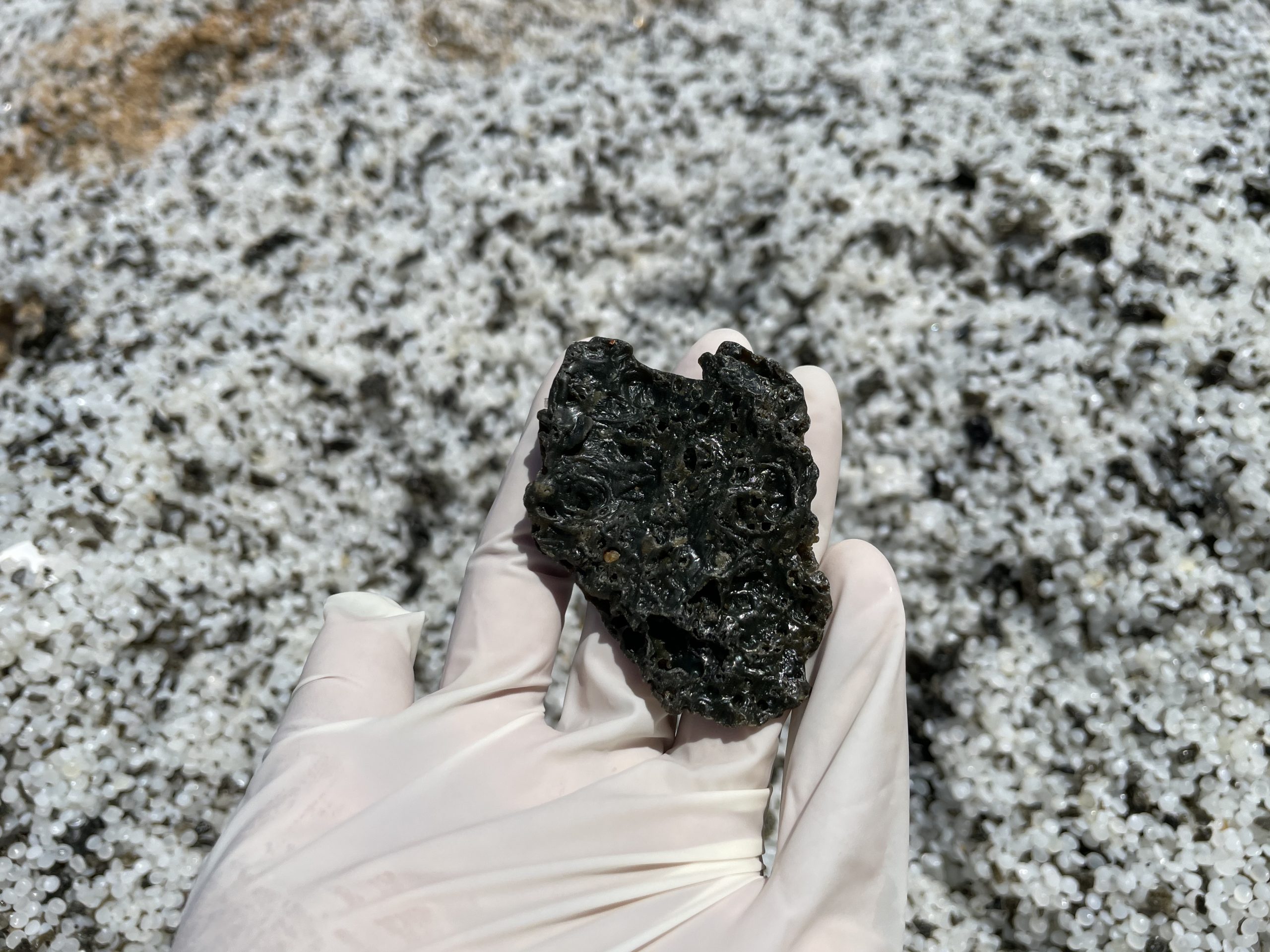
This is one of the biggest unknowns about plastic pollution in general. All plastics are different and all behave differently in the ocean. While most people think plastics persist for hundreds or thousands of years, several peer-reviewed studies report that they can break down in the environment over much shorter periods of time. Additional factors affecting the longevity of nurdles include their color and size.
We know that plastics similar to those released in this spill are non-biodegradable.. But it also appears that, when released into the environment, PE can be broken down into smaller and smaller pieces by sunlight and eventually converted to carbon dioxide and removed from the environment. But the timeline of these processes tare highly variable and depend on a number of factors, including the density of the PE, the location and time of year they are released, or the amount of exposure to sunlight they receive.
More about the environmental persistence of plastic in the ocean:
- Ward, CP & Reddy, CM (2020), We need better data about the environmental persistence of plastic goods
- Ward, CP; Armstrong, CJ; Walsh, AN;Jackson, JJ & Reddy, CM (2019), Sunlight converts polystyrene into carbon dioxide and dissolved organic carbon
PE is widely used because it is so durable. In fact, it is used to make containers that hold strong acids such as many of those released in the spill. In addition, most of the chemicals released from the ship quickly became diluted by seawater, further limiting their potential effects on the plastic. PE can, however, begin to break down under exposure to UV light, changing its physical characteristics, including its permeability and imperviousness to other chemicals. Many of the nurdles released from the ship were reportedly burned, which would also affect their physical and chemical properties.
Plastics the size of nurdles, if consumed by most fish, are likely to pass completely through the intestine and be excreted. However, that means any fish or shellfish that are eaten whole (including their digestive tract) could have nurdles in them.
At this point, it’s difficult to say, as each type of habitat will react differently to the presence of plastics. Deciding whether to remove the nurdles can be as straightforward as shoveling or bulldozing them from beaches into large piles for disposal. But more sensitive parts of the coastline, such as mangroves or coral reefs, will require careful consideration and planning so that clean-up efforts do not cause more damage than the plastic itself.
There are many ways to clean up the plastic debris. It will take time and resources, but tools exist to aid in these efforts. The success of clean-up operations will depend on how quickly the nurdles can be contained and collected. While removing every pellet from the environment is unrealistic, cleaning up this local, relatively contained spill will be much easier than trying to clean up plastics in the open ocean that are widely distributed, come from many sources, and are a complex mixture of types and compositions.
Still, there are some areas along the coast that will present challenges. Deciding whether to proceed with clean-up or to let nature take its course will need to be made on a case-by-case basis, after careful consideration of all the variables.
The Marine Pollution Surveillance Program at the National Oceanic and Atmospheric Administration (NOAA) has analyzed satellite images collected June 5-8 and concluded that there is “possible oil” leaking from the M/V X-Press Pearl. The June 8 report estimated the coverage of this material to be 0.35 km2 or 0.14 square miles, which would equate to 10 to 100 gallons of oil on the surface.
Satellites are a powerful and useful tool in detecting spills, monitoring and assessing ongoing events, and planning countermeasures. However, false positives do occur (such as those caused by algal blooms) and satellite remote sensing does not provide absolute certainty of the presence of oil, the type of oil, or the amount being released. Standard protocol is to verify by local means (plane, helicopter, boat, or drone) and, if necessary, to collect samples and conduct chemical analysis of the suspected oil to constrain its composition and source. In particular, analysis would be able to tell responders whether a leak was coming from the ship’s cargo hold or fuel tanks, indicating potential for a much larger release, or if the source was from the ship’s machinery and superstructure, indicating a more limited source of lubricating oil or other material.
Even though the M/V X-Press Pearl is a cargo ship, and not an oil tanker, there is still a danger of an oil spill, because every ship contains either some type of oil or fuel that is used to run the engines (see below). Various reports have put the amount of fuel in the ship’s tanks at “hundreds of tonnes” to between 278 and 350 metric tonnes. But the exact mix of fuels in the tanks is uncertain.
This is important because different hydrocarbons have different densities, which means an accurate conversion from weight to volume is difficult to make. However, given the range of weights and the range of densities of the different possible fuels, a rough estimate of 80,000 to 100,000 gallons is within reason. But that is what may have been in the tanks at the start of the incident. In the process of the ship sinking, it burned extensively, which may have included some or all of the vessel’s fuel—or the fire may have converted some of the fuel into a heavier, more viscous form. If none of the latter occurred, it is rare that every drop of oil will leak, as there is more than one hold or tank on a ship.
One rule of thumb that may not necessarily remain true here, is 10% of a non-tank ship’s total capacity is most likely to leak in the event of an accident, and it is important to point out that cargo ships (ie, non-tank ships) account for more spills worldwide than oil tankers.
More information:
- Congressional Research Service, “Oil Spills: Background and governance” (2017)
- Farrington, JW, “Mixing oil and water,” Oceanus 43:1(2004).
Marine oil spills are often compared to the 1989 Exxon Valdez spill, which sent 11 million gallons (35,000 metric tonnes) of unrefined crude oil into the waters of Alaska’s Prince William Sound. But the people who respond to oil spills often say every spill is different, and the amount of oil that enters the water is only the first of many variables that can separate a long-term environmental disaster from a near-miss.
In the case of the M/V X-Press Pearl, the biggest uncertainty in predicting what will happen if the ship begins leaking is the composition of its fuel. Various reports have said that the ship carries bunker fuel, gas oil, fuel oil, heavy fuel, or marine fuel, among others. Each of these has its own range of characteristics, but in general, ship fuel divides into one of three types: marine gas oil, marine diesel oil, and fuel oil.
Each of these (and all hydrocarbon products) are produced by distilling crude oil into products that are increasingly denser and less volatile with every succeeding step of the distillation process. Marine gas oil is a highly refined hydrocarbon similar to diesel fuel. At the other end of the spectrum is fuel oil (or bunker fuel), which is often considered a byproduct of the distillation process. It is a viscous, almost asphalt-like substance (hence “heavy”) that needs to be mixed with more refined products in order to make it usable. In between these is marine diesel oil, which is closer to a marine gas oil, but includes some “heavy” material.
Despite its black, tarry appearance, fuel oil in the ocean is often much easier to clean than spills of other hydrocarbons. In the ocean, it often forms thick, buoyant mats that are easily identified, and can be contained with floating booms or skimmed off the surface with specialized equipment. If a fuel oil slick reaches shore however, it can be difficult to remove from beaches, rocks, vegetation, or wildlife and may persist for a long time. Its persistence in the environment does not, however, mean that fuel oil is toxic to the animals and ecosystem in which it is trapped.
Marine fuel oil, and the lighter components of marine diesel oil, spread widely and rapidly across the surface of the ocean, forming a characteristic rainbow-hued slick that is less viscous and harder to contain and recover than a fuel oil spill. Moreover, depending on the environmental conditions, these lighter fuels can also mix into the water column and lead to a greater chance of harm to sea life as plants and animals quickly find themselves enveloped in a coat of toxic hydrocarbons. As a result, pound-for-pound and over the short term, diesel fuel is often significantly more damaging to the environment than fuel oil. The only advantage is that lighter hydrocarbons evaporate more quickly and can dissolve into the water column more readily than spills of heavier hydrocarbons.
This threat also includes toxicity to humans, as oil spill response teams are forced to breathe fumes from evaporating hydrocarbons or make physical contact with spilled material during containment and clean-up. Added to this mix of variables is the unprecedented spill of plastic nurdles from the ship. Hydrocarbons in the water can be absorbed by or adhere to the plastic. This provides an additional mechanism for a spill to be transported through the marine ecosystem. It also makes clean-up of the nurdles more difficult because the clumps of oiled pellets that form have to be handled as a toxic substance, rather than the inert, mostly harmless (to humans) material they are when clean.
More information:
- Coastal Response Research Center(CRRC)
- ExxonMobil, Oil Spill Response Field Manual, 2014.
- ITOPH
- NOAA Office of Response & Restoration
- Oceanography: Special Issue on GoMRI: Deepwater Horizon Oil Spill and Ecosystem Science
- Oceanography: Special Issue on the Gulf of Mexico Research Initiative: Ten Years of Oil Spill and Ecosystem Science(2021).
- Reddy, CR, “Oil in our coastal backyard,” Oceanus, 43:1(2004)
- Sea Grant Programs of the Gulf of Mexico, “Frequently asked questions: Oil edition”.
- Sea Grant Programs of the Gulf of Mexico, “Predicting the movement of oil”.
Click on the following link to download the Fact sheet – June 23, 2021
Click on the following link to download the Fact sheet – May 24, 2022
Impacts on marine species and ecosystems
Prepared by the IUCN Cetacean Specialist Group on request from Oceanswell
Plastic affects cetaceans either through ingestion or entanglement. Filter-feeders seem to be particularly prone to microplastic (< 5mm) ingestion and contamination by plastic-associated toxins due to the large volumes of water they process during feeding, as well as trophic transfer (Fossi et al. 2014, 2016; Alava 2020). However, microplastics have also been found in several non-suspension feeding cetacean species (Xiong et al. 2018; Hernandez-Gonzalez et al. 2018; Nelms et al. 2019; Zhu et al. 2019; Moore et al. 2020; Novillo et al. 2020), although this is relatively poorly studied (Zantis et al., 2021) and ingested microplastics in odontocetes appear to be transitory (Nelms et al. 2019). The ingestion of larger items of plastics is more commonly observed in toothed cetaceans where evidence suggests that the species’ feeding and diving behaviour, rather than the availability of plastic in the water correlates to the rate of ingestion (Di Beneditto and Oliveira 2019). While ingestion of macroplastics is mostly considered a contributing cause of death, lethal cases, where plastic bags fully occluded gastrointestinal passages or filled up stomach cavities, are reported worldwide (Secchi and Zarzur 1999; de Stephanis et al. 2013; Alexiadou et al. 2019). The most commonly reported health effects of plastic ingestion are laceration or ulceration of the gastro-intestinal tract (GIT), leading to infection and internal bleeding, direct blockage of the digestive tract (DT), reducing or preventing nutrient uptake, satiation (i.e. reducing the urge to feed), failure of DT compartmentalisation, allowing gastric secretions into areas not adequately shielded and retention leading to an increasing amount of debris in the digestive system of the organism (Gregory 1991; Laist 1997; Secchi and Zarzur 1999; Derraik 2002; Stamper et al. 2006; Jacobsen et al. 2010; de Stephanis et al. 2013; Alexiadou et al. 2019).
Entanglement in marine plastic affects both mysticetes and odontocetes (e.g. Laist 1997; Butterworth et al. 2012; Baulch and Perry 2014). Most of entanglements involve fishery related items (e.g. Cassoff et al. 2011); however, in most cases, it is difficult to differentiate between actual entanglement in abandoned, lost or discarded fishing gear (ALDFG) and bycatch, i.e. entanglement in active gear (Stelfox et al. 2016; Asmutis-Silvia et al. 2017; Stelfox 2017). Entanglement in marine debris can cause decreased swimming ability and compromised or restricted movement leading to disruption in feeding and breathing and an increased energy budget, as well as life-threatening injuries ranging from abscess formation and infection to amputation and ultimately death (Moore and van der Hoop 2012; Baulch and Perry 2014; van der Hoop et al. 2016).
- Alava, J.J., 2020. Modeling the Bioaccumulation and Biomagnification Potential of Microplastics in a Cetacean Foodweb of the Northeastern Pacific: A Prospective Tool to Assess the Risk Exposure to Plastic Particles. Mar. Sci. 7. https://doi.org/10.3389/fmars.2020.566101
- Alexiadou, P., Foskolos, I., Frantzis, A., 2019. Ingestion of macroplastics by odontocetes of the Greek Seas, Eastern Mediterranean: Often deadly! Marine Pollution Bulletin 146, 67–75. https://doi.org/10.1016/j.marpolbul.2019.05.055
- Asmutis-Silvia, R., Barco, S., Cole, T., Henry, A., Johnson, A., Knowlton, A., Landry, S., Mattila, D., Moore, M., Robbins, J., van der Hoop, J., 2017. Rebuttal to published article “A review of ghost gear entanglement amongst marine mammals, reptiles and elasmobranchs” by M. Stelfox, J. Hudgins, and M. Sweet. Marine Pollution Bulletin 117, 554–555. https://doi.org/10.1016/j.marpolbul.2016.11.052
- Baulch, S., Perry, C., 2014. Evaluating the impacts of marine debris on cetaceans. Marine Pollution Bulletin 80, 210–221. https://doi.org/10.1016/j.marpolbul.2013.12.050
- Butterworth, A., Clegg, I., Bass, C., 2012. Marine debris: a global picture of the impact on animal welfare and of animal-focused solutions.
- Cassoff, R.M., Moore, K.M., McLellan, W.A., Barco, S.G., Rotsteins, D.S., Moore, M.J., 2011. Lethal entanglement in baleen whales. Dis Aquat Organ 96, 175–185. https://doi.org/10.3354/dao02385
- de Stephanis, R., Giménez, J., Carpinelli, E., Gutierrez-Exposito, C., Cañadas, A., 2013. As main meal for sperm whales: Plastics debris. Marine Pollution Bulletin 69, 206–214. https://doi.org/10.1016/j.marpolbul.2013.01.033
- Derraik, J.G.B., 2002. The pollution of the marine environment by plastic debris: a review. Marine Pollution Bulletin 44, 842–852. https://doi.org/10.1016/S0025-326X(02)00220-5
- Di Beneditto, A.P.M., Oliveira, A. da S., 2019. Debris ingestion by carnivorous consumers: Does the position in the water column truly matter? Marine Pollution Bulletin 144, 134–139. https://doi.org/10.1016/j.marpolbul.2019.04.074
- Fossi, M.C., Coppola, D., Baini, M., Giannetti, M., Guerranti, C., Marsili, L., Panti, C., de Sabata, E., Clò, S., 2014. Large filter feeding marine organisms as indicators of microplastic in the pelagic environment: The case studies of the Mediterranean basking shark (Cetorhinus maximus) and fin whale (Balaenoptera physalus). Marine Environmental Research 100, 17–24. https://doi.org/10.1016/j.marenvres.2014.02.002
- Fossi, M.C., Marsili, L., Baini, M., Giannetti, M., Coppola, D., Guerranti, C., Caliani, I., Minutoli, R., Lauriano, G., Finoia, M.G., Rubegni, F., Panigada, S., Bérubé, M., Urbán Ramírez, J., Panti, C., 2016. Fin whales and microplastics: The Mediterranean Sea and the Sea of Cortez scenarios. Environ Pollut 209, 68–78. https://doi.org/10.1016/j.envpol.2015.11.022
- Gregory, M.R., 1991. The hazards of persistent marine pollution: drift plastics and conservation islands. Journal of the Royal Society of New Zealand 21, 83–100. https://doi.org/10.1080/03036758.1991.10431398
- Hernandez-Gonzalez, A., Saavedra, C., Gago, J., Covelo, P., Santos, M.B., Pierce, G.J., 2018. Microplastics in the stomach contents of common dolphin (Delphinus delphis) stranded on the Galician coasts (NW Spain, 2005–2010). Marine Pollution Bulletin 137, 526–532. https://doi.org/10.1016/j.marpolbul.2018.10.026
- Jacobsen, J.K., Massey, L., Gulland, F., 2010. Fatal ingestion of floating net debris by two sperm whales (Physeter macrocephalus). Mar. Pollut. Bull. 60, 765–767. https://doi.org/10.1016/j.marpolbul.2010.03.008
- Laist, D.W., 1997. Impacts of Marine Debris: Entanglement of Marine Life in Marine Debris Including a Comprehensive List of Species with Entanglement and Ingestion Records, in: Coe, J.M., Rogers, D.B. (Eds.), Marine Debris. Springer New York, New York, NY, pp. 99–139. https://doi.org/10.1007/978-1-4613-8486-1_10
- Moore, M.J., van der Hoop, J.M., 2012. The Painful Side of Trap and Fixed Net Fisheries: Chronic Entanglement of Large Whales [WWW Document]. Journal of Marine Biology. https://doi.org/10.1155/2012/230653
- Moore, R.C., Loseto, L., Noel, M., Etemadifar, A., Brewster, J.D., MacPhee, S., Bendell, L., Ross, P.S., 2020. Microplastics in beluga whales (Delphinapterus leucas) from the Eastern Beaufort Sea. Mar Pollut Bull 150, 110723. https://doi.org/10.1016/j.marpolbul.2019.110723
- Nelms, S.E., Barnett, J., Brownlow, A., Davison, N.J., Deaville, R., Galloway, T.S., Lindeque, P.K., Santillo, D., Godley, B.J., 2019. Microplastics in marine mammals stranded around the British coast: ubiquitous but transitory? Scientific Reports 9, 1075. https://doi.org/10.1038/s41598-018-37428-3
- Novillo, O., Raga, J.A., Tomás, J., 2020. Evaluating the presence of microplastics in striped dolphins (Stenella coeruleoalba) stranded in the Western Mediterranean Sea. Mar Pollut Bull 160, 111557. https://doi.org/10.1016/j.marpolbul.2020.111557
- Secchi, E.R., Zarzur, S., 1999. Plastic debris ingested by a Blainville’s beaked whale, Mesoplodon densirostris, washed ashore in Brazil 4.
- Stamper, M.A., Whitaker, B.R., Schofield, T.D., 2006. Case study: Morbidity in a pygmy sperm whale Kogia breviceps due to ocean-bourne plastic. Marine Mammal Science 22, 719–722. https://doi.org/10.1111/j.1748-7692.2006.00062.x
- Stelfox, M., 2017. Review of “Rebuttal to published article ‘A review of ghost gear entanglement amongst marine mammals, reptiles and elasmobranchs’ by M. Stelfox, J. Hudgins, and M. Sweet.” Marine Pollution Bulletin 117, 556–557. https://doi.org/10.1016/j.marpolbul.2016.11.053
- Stelfox, M., Hudgins, J., Sweet, M., 2016. A review of ghost gear entanglement amongst marine mammals, reptiles and elasmobranchs. Marine Pollution Bulletin 111, 6–17. https://doi.org/10.1016/j.marpolbul.2016.06.034
- van der Hoop, J., Corkeron, P., Moore, M., 2016. Entanglement is a costly life‐history stage in large whales. Ecol Evol 7, 92–106. https://doi.org/10.1002/ece3.2615
- Xiong, X., Chen, X., Zhang, K., Mei, Z., Hao, Y., Zheng, J., Wu, C., Wang, K., Ruan, Y., Lam, P.K.S., Wang, D., 2018. Microplastics in the intestinal tracts of East Asian finless porpoises (Neophocaena asiaeorientalis sunameri) from Yellow Sea and Bohai Sea of China. Marine Pollution Bulletin 136, 55–60. https://doi.org/10.1016/j.marpolbul.2018.09.006
- Zantis, L.J., Carroll, E.L., Nelms, S.E., Bosker, T., 2021. Marine mammals and microplastics: A systematic review and call for standardisation. Environmental Pollution 269, 116142. https://doi.org/10.1016/j.envpol.2020.116142
- Zhu, J., Yu, X., Zhang, Q., Li, Y., Tan, S., Li, D., Yang, Z., Wang, J., 2019. Cetaceans and microplastics: First report of microplastic ingestion by a coastal delphinid, Sousa chinensis. Science of The Total Environment 659, 649–654. https://doi.org/10.1016/j.scitotenv.2018.12.389
Prepared by Prof. Antonio Fernandez, (Veterinary Pathology Professor) and member of the IUCN Cetacean Specialist Group on request from Oceanswell.
The acute, subacute, and accumulative chronic effects of contaminants on cetacean health are scientifically proven. The wide range of reported effects include poor body condition, calcium imbalance, inflammation, reproductive failure, organ damage (lung disease and failure, adrenal gland disease), altered hepatobiliary function, immune changes and increased susceptibility to infections, reproductive problems, impaired stress response, and death (Geraci and St. Aubin, 1982; Schwacke et al., 2014; Lane et al., 2015; Venn-Watson et al., 2013, 2015a; Colegrove et al., 2016; DWH NRDA Trustees, 2016; De Guise et al., 2017; Kellar et al., 2017; Smith et al., 2017; Jessup and Leighton, 1996; Johnson and Ziccardi, 2006; Helm et al., 2015).
Toxic effects of oil resulted in some dolphin and whale stocks losing over half of their population, and without any active restoration, these stocks may take over 50 years to recover (DWH NRDA Trustees, 2016).
References:
- Geraci, J. R., & St Aubin, D. J. (1982). Study of the effects of oil on cetaceans.
- Schwacke, L. H., Smith, C. R., Townsend, F. I., Wells, R. S., Hart, L. B., Balmer, B. C., Collier, T. K., De Guise, S., Fry, M. M, Guillette L. J., Lamb, S. V., Lane, S. M., McFee, W. E., Place, N. J., Tumlin, M.C., Ylitalo, G. M., Zolman, E. S., & Rowles, T. K. (2014). Health of common bottlenose dolphins (Tursiops truncatus) in Barataria Bay, Louisiana, following the Deepwater Horizon oil spill. Environmental Science & Technology, 48(1), 93-103. https://doi.org/10.1021/es403610f
- Colegrove, K. M., Venn-Watson, S., Litz, J., Kinsel, M. J., Terio, K. A., Fougeres, E., …& Rowles, T. K. (2016). Fetal distress and in utero pneumonia in perinatal dolphins during the Northern Gulf of Mexico unusual mortality event. Diseases of Aquatic Organisms, 119(1), 1-16. https://doi.org/10.3354/dao02969
- De Guise, S., Levin, M., Gebhard, E., Jasperse, L., Hart, L. B., Smith, C. R., Venn-Watson, S., Townsend, F., Wells, R., Balmer, B., Zolman, E., Rowles, T., & Schwacke, L. (2017). Changes in immune functions in bottlenose dolphins in the northern Gulf of Mexico associated with the Deepwater Horizon oil spill. Endangered Species Research, 33, 291-303. https://doi.org/10.3354/esr00814
- Kellar, N. M., Speakman, T. R., Smith, C. R., Lane, S. M., Balmer, B. C., Trego, M. L., … & Schwacke, L. H. (2017). Low reproductive success rates of common bottlenose dolphins Tursiops truncatus in the northern Gulf of Mexico following the Deepwater Horizon disaster (2010-2015). Endangered Species Research, 33, 143-158. https://doi.org/10.3354/esr00775
- Jessup, D. A., & Leighton, F. A. (1996). Oil pollution and petroleum toxicity to wildlife. Non-infectious diseases of wildlife, Iowa State University Press, Ames, Iowa, 141-157.
- Johnson, S., & Ziccardi, M. (2006). Marine mammal oil spill response guidelines. NOAA Fisheries Guidance Document-Draft, 4(10), 2006.
- Helm, R. C., Costa, D. P., DeBruyn, T. D., O’Shea, T. J., Wells, R. S., & Williams, T. M. (2015). Overview of effects of oil spills on marine mammals. In Handbook of Oil Spill Science and Technology (pp. 455-475). Wiley-Blackwell.
Prepared by the IUCN Shark Specialist Group on request from Oceanswell
There are 98 Chondrichthyan species in Sri Lanka and at total of 85 % (84 species) are either threatened or Near Threatened. Specifically, two-thirds (69%, 68 species) are threatened: Critically Endangered (15 species), Endangered (26) or Vulnerable (27). This is one of the highest threat levels for Chondrichthyans any country in the world. While these species are primarily threatened by overfishing and habitat degradation and loss, additional stressors such as pollution will likely further worsen the already perilous status of shark, rays and ghostsharks in Sri Lankan waters.
Prepared by the IUCN Marine Fish Specialist Group on request from Oceanswell
Plastic pollution is being enumerated in the water, sediment, and fauna of Sri Lanka (see Thushari and Senevirathna 2020 and references therein). Of particular interest for our species is Praboda et al. (2020), which found 30.17 ± 3.58 items/100mg in gut 29.33 ± 1.19 items/g in muscles of Commerson’s Anchovy, Stolephorous commersonnii. The only type of microplastics found, polypropylene, is found in fishing ropes, netting materials, bottle caps, and packaging materials (Praboda et al. 2020). The lethal and sublethal effects of microplastics on marine fishes are of great interest (see Foley et al. 2018 for a meta-analysis). Impacts may vary depending on the species, life history stage, concentration, and other factors. For example, Pannetier et al. 2020 found mainly sublethal effects of microplastics at realistic concentrations on juvenile fishes.
References:
- Thushari, G.G.N. and Senevirathna, J.D.M., 2020. Plastic pollution in the marine environment. Heliyon, 6(8), p.e04709. https://doi.org/10.1016/j.heliyon.2020.e04709
- Praboda, M. W. K., Egodauyana, K. P. U. T., Wijethunga, H. N. S., Abeygunawardana, A. P., Senevirathna, J. D. M., & Thushari, G. G. N. (2020). Occurrence of Microplastics in Gut and Muscles of Commerson’s Anchovy in Madu-Ganga Estuary of Southern Province, Sri Lanka. http://www.erepo.lib.uwu.ac.lk/bitstream/handle/123456789/5649/proceeding_oct_08-117.pdf?sequence=1&isAllowed=y
- Foley, C. J., Feiner, Z. S., Malinich, T. D., & Höök, T. O. (2018). A meta-analysis of the effects of exposure to microplastics on fish and aquatic invertebrates. Science of the total environment, 631, 550-559. https://doi.org/10.1016/j.scitotenv.2018.03.046
- Pannetier, P., Morin, B., Le Bihanic, F., Dubreil, L., Clérandeau, C., Chouvellon, F., Van Arkel, K., Danion, M. and Cachot, J., 2020. Environmental samples of microplastics induce significant toxic effects in fish larvae. Environment international, 134, p.105047. https://doi.org/10.1016/j.envint.2019.105047
Prepared by the IUCN Marine Fish Specialist Group on request from Oceanswell
Direct impacts of oil spills on marine fishes are hard to document, as other factors (such as reduced fishing pressure) may also be introduced. For example, Fodrie et al. (2014) provides a review of 16 papers in which the responses of estuarine fishes in the Gulf of Mexico to oil spills were explicitly examined, noting that studies at an organismal level (n = 10) consistently document negative effects while those at a population (n = 6) level routinely fail to detect damages related to oil pollution. To reconcile these apparent contradictions, Fodrie et al. (2014) provide suggestions for the potential mechanisms that could be at work. The introduction in Langangen et al. (2017) provides additional information on the potential impacts of oil spills on marine fishes, particularly for the early life history stages.
References:
- Fodrie, F.J., Able, K.W., Galvez, F., Heck Jr, K.L., Jensen, O.P., López-Duarte, P.C., Martin, C.W., Turner, R.E. and Whitehead, A. (2014). Integrating organismal and population responses of estuarine fishes in Macondo spill research. BioScience, 64(9), pp.778-788. https://doi.org/10.1093/biosci/biu123
- Langangen, Ø., Olsen, E., Stige, L.C., Ohlberger, J., Yaragina, N.A., Vikebø, F.B., Bogstad, B., Stenseth, N.C. and Hjermann, D.Ø. (2017). The effects of oil spills on marine fish: Implications of spatial variation in natural mortality. Marine Pollution Bulletin, 119(1), pp.102-109. https://doi.org/10.1016/j.marpolbul.2017.03.037
Prepared by K. Lindeman of the IUCN Snapper, Seabream and Grunt Specialist Group
Dozens of species from the SSG SG are present on the coast of Sri Lanka affected by this issue. Many of these species use a wide array of coastal habitats from very shallow water to deeper reefs. Oil spills and plastics can effect various physiological processes including feeding and reproduction for many SSG species. Here is some basic information.
Diverse studies have documented physiological problems associated with the ingestion of micro- and nano-plastics as a result of accumulations in organs. Differing life stages ingest the plastics from different sources (e.g., larvae via zooplankton, adults via fishes or invertebrates). Impacts on individual fishes can be sub-lethal or potentially lethal. Importantly, once plastics are ingested by a fish, the particles then pass across trophic levels via predation. The entire food web that SSG species exist within is susceptible
Prepared by the IUCN SSC Seahorse, Pipefish and Seadragon Specialist Group on request from Oceanswell.
Sri Lanka is home to 16 species of syngnathid fishes including two seahorses that are considered globally threatened by the IUCN Red List. Hippocampus kuda and Hipppocampus spinosissimus are both Vulnerable and face a number of threats globally such as bycatch and trade but also habitat degradation and loss that undoubtedly includes pollution of their habitats.
It is well known that oil spills cause detrimental effects to marine life in our oceans and can harm both aquatic and terrestrial ecosystems. Seahorses, in particular, are highly susceptible to local anthropogenic disturbances due to their unique life history traits such as low population densities, low mobility, small home ranges, low fecundity, lengthy parental care and mate fidelity (Foster & Vincent, 2004). When exposed to local stressors, seahorses do not have the ability or luxury to simply move to another location and will often remain, ultimately increasing their level of exposure.
Recent evidence shows the importance of mitigating the harmful effects of pollution to conserve and protect seahorses (Foster & Vincent, 2004). Pollutants and excessive nutrients can lead to eutrophication, hypoxia and damages seahorse habitats (Santos et al, 2010). These factors can have a direct impact to the conservation status of species, especially at the local and/or national level.
Seahorses suffer from both direct and indirect impacts of oil spills which can lead to changes in gill tissue, reduced oxygen uptake and loss of organ function and can also have genotoxic effects (i.e. DNA or chromosomal damage) (Foster & Vincent, 2004).
Seahorse are voracious eaters and rely on small crustaceans as their primary food source and as such are at an elevated risk of ingesting microplastics. Although harmful in themselves, microplastics will also pick up and carry heavy metals, pollutants and chemicals on their surface. The first study to examine the effects on microplastic on seahorse growth and anatomy found early evidence that pollutants such as heavy metals that attach microplastics can slow seahorse growth and increase mortality (Foster & Vincent, 2004).
References:
- Foster, S. A., & Vincent, A. C. (2004). Life history and ecology of seahorses: implications for conservation and management. Journal of fish biology, 65(1), 1-61. https://doi.org/10.1111/j.0022-1112.2004.00429.x
- Santos, C. A., Novaes, L. S., & Gomes, L. C. (2010). Genotoxic effects of the diesel water-soluble fraction on the seahorse Hippocampus reidi (Teleostei: Syngnathidae) during acute exposure. Zoologia (Curitiba), 27(6), 956-960. https://doi.org/10.1590/S1984-46702010000600017
Prepared by Dr. David Obura, from the IUCN Coral Specialist Group on request from Oceanswell
The impacts of oil and chemical spills, and plastic debris, on shallow coral reefs are varied, as corals and other species are impacted by toxic pollution, resultant compromise of health and/or death of tissue, and diseases may ensue from these. Physical littering by plastics and other debris can cause direct damage and obstruction, as well as by being eaten by many species, compromising their health and even causing death. As damaging can be any dispersants and other chemicals used, such as to disperse oil spills. Preventing any of these reaching shallow waters is critical, principally making every effort to prevent and contain initial or continued spillage, such as by using booms and other physical barriers. Damage to coral reefs, already stressed by coastal development and global warming may not be recoverable, and the coral reefs are key assets for coastal protection and the tourism sector, as well as fisheries.
References:
- Shafir, S., Van Rijn, J., & Rinkevich, B. (2007). Short and long term toxicity of crude oil and oil dispersants to two representative coral species. Environmental science & technology, 41(15), 5571-5574.https://doi.org/10.1021/es0704582
- Jones, R. J., & Heyward, A. J. (2003). The effects of Produced Formation Water (PFW) on coral and isolated symbiotic dinoflagellates of coral. Marine and Freshwater Research, 54(2), 153-162. https://doi.org/10.1071/MF02108
- Lamb JB, Willis BL, Fiorenza EA, et al (2018) Plastic waste associated with disease on coral reefs. Science, 359:460–462. https://doi.org/10.1126/science.aar3320
Prepared by the IUCN Seagrass Species Specialist Group on request from Oceanswell
Sri Lanka is part of the Indo-Pacific Seagrass Bioregion and is home to 15 seagrass species representing seven genera, one of which is listed as vulnerable, and possibly endangered. Seagrasses are the basis of an important coastal ecosystem that produces protein for humans and large animal species, and is eaten directly by protected turtles and dugongs. Seagrasses filter the water and protect coastlines from storm damage, interacting with coral reefs and mangroves.
The total extent of underwater seagrass meadows in Sri Lanka is estimated to be 371.37 square kilometers. The area directly north of the X-Press Pearl disaster accounts for more than 75% of the country’s seagrass extent and supports more than 50% of fisheries production. Previous research has investigated linkages between seagrass meadows and food security in Sri Lanka. Underwater video systems were used to assess habitat and count fish. The study provides a baseline of pre-disaster conditions.
Clarification related to comments made on 5th July on Derana TV
